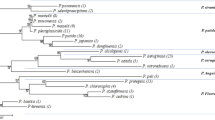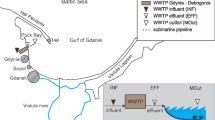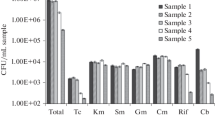Abstract
Antimicrobial-resistant bacteria (ARB) carrying antimicrobial resistance genes (ARGs) have been increasingly detected in water sources. Pseudomonas sp. are opportunistic pathogens commonly reported in water samples and different antimicrobial resistance mechanisms have been described in Pseudomonas sp., producing multidrug-resistant (MDR) phenotype. Besides, the presence of heavy metal resistance genes (HMRGs) may select ARB, which is worrying. Therefore, this study aimed to characterize the genotypes of Pseudomonas sp. isolated from different water sources. Water samples (i.e., rivers, streams, lakes and sewage treatment plants) were collected from different cities in Brazil. The bacterial identification was performed by sequencing the 16S rDNA and the resistance profile to antimicrobials and heavy metals were determined by minimum inhibitory concentration (MIC). Several ARGs, HMRGs, and plasmids were researched by PCR and the amplicons were sequenced for confirmation. A total of 23 Pseudomonas sp. isolates were obtained and identified as Pseudomonas saponiphila, Pseudomonas hunanensis, Pseudomonas aeruginosa, and Pseudomonas asiatica. These isolates presented high MICs to antimicrobials and heavy metals, being the great majority (n = 21; 91%) classified as MDR. Different clinically important ARGs were detected, such as blaGES, qnrS, qepA, tetB, aac(3′)-IIa, and ant(2″)-Ia. The czcA gene was the only HMRG detected and no plasmids were found. To the best of our knowledge, this is the first report of the world of P. saponiphila carrying ARGs (i.e., blaGES, qnrS, aac(3′)-IIa, tetB) and QepA-producing P. hunanensis and the first time of P. saponiphila, P. asiatica, and P. hunanensis in Brazil.


Similar content being viewed by others
References
Kumar R, Padhye LP (2017) Fate of environmental pollutants. Water Environ Res 89:1603–1633. https://doi.org/10.2175/106143017X15023776270601
Garner E, Inyang M, Garvey E, Parks J, Glover C, Grimald A, Dickenson E, Sultherland J, Salveson A, Eduards MA, Pruden A (2019) Impact of lending for direct potable reuse on premise plumbing microbial ecology and regrowth of opportunistic pathogens and antibiotic. Water Res 151:75–86. https://doi.org/10.1016/j.watres.2018.12.003
Reddy B, Dubey SK (2019) River ganges water as reservoir of microbes with antibiotic and metal ion resistence genes: high throughput metagenomics approach. Environ Pollut 246:443–451. https://doi.org/10.1016/j.envpol.2018.12.022
Fuentefria DB, Ferreira AE, Corção G (2011) Antibiotic-resistant Pseudomonas aeruginosa from hospital wastewater and superficial water: are they genetically related? J Environ Manag 92:250–255. https://doi.org/10.1016/j.jenvman.2010.09.001
Bird K, Boopathy R, Nathaniel R, LaFleur G (2019) Water pollution and observation of acquired antibiotic resistence in Bayou Lafouche, a major drinking water source in Southeast Louisiana, USA. Environ Sci Pollut Res Int. https://doi.org/10.1007/s11356-018-4008-5
Hao CS, You SL, Chang GP, Chen J, Liang YH, Guang GY (2018) Persistence of antibiotic resistance genes and bacterial community changes in drinking water treatment system: from drinking water source to tap water. Sci Total Environ 616:453–461. https://doi.org/10.1016/j.scitotenv.2017.10.318
Monbini S, Rezatofighi SE, Kiyani L, Motamedi H (2019) Diversity and metallo- β-lactamase-producing genes in Pseudomonas aeruginosa strains isolated from filters of household water treatment systems. J Environ Manag 231:413–418. https://doi.org/10.1016/j.jenvman.2018.10.068
Deredjian A, Colinon C, Brothier E, Favre-Bonté S, Cournoyer B, Nazaret S (2011) Antibiotic and metal resistance among hospital and outdoor strains of Pseudomonas aeruginosa. Res Microbiol 162:689–700. https://doi.org/10.1016/j.resmic.2011.06.007
Weisburg WG, Barns SM, Pelletier BA, Lane DJ (1991) 16S ribosomal DNA amplification for phylogenetic study. J Bacteriol 173:697–703. https://doi.org/10.1128/jb.173.2.697-703.1991
Yoon SH, Ha SM, Kwon S, Lim J, Kim Y, Seo H, Chun J (2017) Introducing EzBioCloud: a taxonomically united database of 16S rRNA gene sequences and whole-genome assemblies. Int J Syst Evol Microbiol 67:1613–1617. https://doi.org/10.1099/ijsem.0.001755
CLSI (2018) Performance standards for antimicrobial susceptibility testing: twenty-eighth informational supplement. CLSI document M100-S28. Clinical and Laboratory Standards Institute, Wayne, PA
Magiorakos AP, Srinivasan A, Carey RB, Carmeli Y, Falagas ME, Giske CG, Harbarth S, Hindler JF, Kahlmeter G, Olsson-Liljequist B, Paterson DL, Rice LB, Stelling J, Struelens MJ, Vatopoulos A, Weber JT, Monnet DL (2012) Multidrug-resistant, extensively drug-resistant and pandrug-resistant bacteria: an international expert proposal for interim standard definitions for acquired resistance. Clin Microbiol Infect 18:268–281. https://doi.org/10.1111/j.1469-0691.2011.03570.x
Noppe-Leclercq I, Wallet F, Haentjens S, Courcol R, Simonet M (1999) PCR detection of aminoglycoside resistance genes: a rapid molecular typing method for Acinetobacter baumannii. Res Microbiol 150:317–322
Keyes K, Hudson C, Maurer JJ, Thayer S, White DG, Lee MD (2000) Detection of florfenicol resistance genes in Escherichia coli isolated from sick chickens. Antimicrob Agents Chemother 44:421–424. https://doi.org/10.1128/aac.44.2.421-424.2000
Ng LK, Martin I, Alfa M, Mulvey M (2001) Multiplex PCR for the detection of tetracycline resistant genes. Mol Cell Probes 15:209–215
Kerrn MB, Klemmensen T, Frimodt-Mǿller N, Espersen F (2002) Susceptibility of Danish Escherichia coli strains isolated from urinary tract infections and bacteraemia, and distribution of sul genes conferring sulphonamide resistance. J Antimicrob Chemother 50:513–516. https://doi.org/10.1093/jac/dkf164
Cattoir V, Poirel L, Rotimi V, Soussy CJ, Nordmann P (2007) Multiplex PCR for detection of plasmid-mediated quinolone resistance qnr genes in ESBL-producing enterobacterial isolates. J Antimicrob Chemother 60:394–397. https://doi.org/10.1093/jac/dkm204
Dallenne C, Da Costa A, Decre D, Favier C, Arlet G (2010) Development of a set of multiplex PCR assays for the detection of genes encoding important beta-lactamases in Enterobacteriaceae. J Antimicrob Chemother 65:490–495. https://doi.org/10.1093/jac/dkp498
Bouskill NJ, Barnhart EP, Galloway TS, Handy RD, Ford TE (2007) Quantification of changing Pseudomonas aeruginosa sodA, htpX and mt gene abundance in response to trace metal toxicity: a potential in situ biomarker of environmental health. FEMS Microbiol Ecol 60:276–286. https://doi.org/10.1111/j.1574-6941.2007.00296.x
Carattoli A, Bertini A, Villa L, Falbo V, Hopkins KL, Threlfall EJ (2005) Identification of plasmids by PCRbased replicon typing. J Microbiol Methods 63:219–228. https://doi.org/10.1016/j.mimet.2005.03.018
García-Fernández A, Fortini D, Veldman K, Mevius D, Carattoli A (2009) Characterization of plasmids harbouring qnrS1, qnrB2 and qnrB19 genes in Salmonella. J Antimicrob Chemother 63:274–281. https://doi.org/10.1093/jac/dkn470
Gao J, Li BY, Wang HH, Liu ZQ (2014) Pseudomonas hunanensis sp. nov., isolated from soil subjected to long-term manganese pollution. Curr Microbiol 69:19–24. https://doi.org/10.1007/s00284-014-0545-4
Lang E, Burghartz M, Spring S, Swiderski J, Spröer C (2018) Pseudomonas benzenivorans sp. nov. and Pseudomonas saponiphila sp. nov., represented by xenobiotics degrading type strains. Curr Microbiol 60:85–91. https://doi.org/10.1007/s00284-009-9507-7
Tohya M, Watanabe S, Teramoto K, Uechi K, Tada T, Kuwahara-Arai K, Kinjo T, Maeda S, Nakasone I, Zaw NN, Mya S, Zan KN, Tin HH, Fujita J, Kirikae T (2019) Pseudomonas asiatica sp. nov., isolated from hospitalized patients in Japan and Myanmar. Int J Syst Evol Microbiol 69:1361–1368. https://doi.org/10.1099/ijsem.0.003316
Tohya M, Tada T, Watanabe S, Kuwahara-Arai K, Zin KN, Zaw NN, Aung MY, Mya S, Zan KN, Kirikae T, Tin HH (2019) Emergence of carbapenem-resistant Pseudomonas asiatica producing NDM-1 and VIM-2 Metallo-β-lactamases in Myanmar. Antimicrob Agents Chemother 63:e00475–e519. https://doi.org/10.1128/AAC.00475-19
Gellatly SL, Hancock RE (2013) Pseudomonas aeruginosa: new insights into pathogenesis and host defenses. Pathog Dis 67:159–173. https://doi.org/10.1111/2049-632X.12033
Bush K, Jacoby GA (2010) Updated functional classification of beta-lactamases. Antimicrob Agents Chemother 54:969–976. https://doi.org/10.1128/AAC.01009-09
Poirel L, Thomas IL, Naas T, Karim A, Nordmann P (2000) Biochemical sequence analyses of GES-1, a novel class A extended-spectrum betalactamase, and the class 1 integron In52 from Klebsiella pneumoniae. Antimicrob Agents Chemother 44:622–632. https://doi.org/10.1128/aac.44.3.622-632.2000
Poirel L, Weldhagen GF, Naas T, De Champs C, Dove MG, Nordmann P (2001) GES-2, a class A betalactamase from Pseudomonas aeruginosa with increased hydrolysis of imipenem. Antimicrob Agents Chemother 45:2598–2603. https://doi.org/10.1128/aac.45.9.2598-2603.2001
Ory J, Bricheux G, Robin F, Togola A, Forestier C, Traore O (2019) Biofilms in hospital effluents as a potential crossroads for carbapenemase-ecoding strains. Sci Total Environ 657:7–15. https://doi.org/10.1016/j.scitotenv.2018.11.427
Polotto M, Casella T, de Lucca Oliveira MG, Rúbio FG, Nogueira ML, de Almeida MT, Nogueira MC (2012) Detection of P. aeruginosa harboring blaCTX-M-2, blaGES-1 and blaGES-5, blaIMP-1 and blaSPM-1 causing infections in Brazilian tertiary-care hospital. BMC Infect Dis 12:176. https://doi.org/10.1186/1471-2334-12-176
Nodari CS, Siebert M, Matte UDS, Barth AL (2017) Draft genome sequence of a GES-5-producing Serratia marcescens isolated in southern Brazil. Braz J Microbiol 48(2):191–192. https://doi.org/10.1016/j.bjm.2016.08.002
Ribeiro VB, Falci DR, Rozales FP, Barth AL, Zavascki AP (2014) Carbapenem-resistant GES-5-producing Klebsiella pneumoniae in Southern Brazil. Braz J Infect Dis 18(2):231–232. https://doi.org/10.1016/j.bjid.2013.12.002
Braz VS, Furlan JPR, Passaglia J, Falcão JP, Stehling EG (2018) Genotypic diversity and presence of β-lactamase encoding genes in Pseudomonas aeruginosa isolated from Brazilian soils. Appl Soil Ecol 129:94–97. https://doi.org/10.1016/j.apsoil.2018.05.005
Furlan JPR, Pitondo-Silva A, Stehling EG (2018) New STs in multidrug-resistant Acinetobacter baumannii harbouring β-lactamases encoding genes isolated from Brazilian soils. J Appl Microbiol 125(2):506–512. https://doi.org/10.1111/jam.13885
Martínez-Martínez L, Pascual A, Jacoby GA (1998) Quinolone resistance from a transferable plasmid. Lancet 351:797–799. https://doi.org/10.1016/S0140-6736(97)07322-4
Yamane K, Wachino JI, Suzuki S, Kimura K, Shibata N, Kato H, Shibayama K, Konda T, Arakawa Y (2007) New plasmid-mediated fluoroquinolone efflux pump, QepA, found in an Escherichia coli clinical isolate. Antimicrob Agents Chemother 51:3354–3360. https://doi.org/10.1128/AAC.00339-07
Zhao HY, Dang H (2012) Coastal seawater bacteria harbor a large reservoir of plasmid-mediated quinolone resistance determinants in Jiaozhou Bay, China. Microb Ecol 64:187–199. https://doi.org/10.1007/s00248-012-000-z
Cayci YT, Coban AY, Gunaydin M (2014) Investigation of plasmid-mediated quinolone resistance in Pseudomonas aeruginosa clinical isolates. Indian J Med Microbiol 32:285–289. https://doi.org/10.4103/0255-0857.136567
Zhang XX, Zhang T, Fang HHP (2009) Antibiotic resistance genes in water environment. Appl Microbiol Biotechnol 82:397–414. https://doi.org/10.1007/s00253-008-1829-z
Adelowo OO, Vollmers J, Mäusezahl I, Kaster AK, Müller JA (2018) Detection of the carbapenemase gene blaVIM-5 in members of the Pseudomonas putida group isolated from polluted Nigerian wetlands. Sci Rep 8:15116. https://doi.org/10.1038/s41598-018-33535-3
Martinez E, Marquez C, Ingold A, Merlino J, Djordjevic SP, Stokes HW, Chowdhury PR (2012) Diverse mobilized class 1 integrons are common in the chromosomes of pathogenic Pseudomonas aeruginosa clinical isolates. Antimicrob Agents Chemother 56:2169–2172. https://doi.org/10.1128/AAC.06048-11
Hishinuma T, Tada T, Kuwahara-Arai K, Yamamoto N, Shimojima M, Kirikae T (2018) Spread of GES-5 carbapenemase-producing Pseudomonas aeruginosa clinical isolates in Japan due to clonal expansion of ST235. PLoS ONE 13:e0207134. https://doi.org/10.1371/journal.pone.0207134
Jain S, Bhatt A (2014) Molecular and in situ characterization of cadmium-resistant diversified extremophilic strains of Pseudomonas for their bioremediation potential. 3 Biotech 4:297–304. https://doi.org/10.1007/s13205-013-0155-z
Scales BS, Erb-Downward JR, Huffnagle IM, LiPuma JJ, Huffnagle GB (2015) Comparative genomics of Pseudomonas fluorescens subclade III strains from human lungs. BMC Genomics 16:1032. https://doi.org/10.1186/s12864-015-2261-2
Pitondo-Silva A, Gonçalves GB, Stehling EG (2016) Heavy metal resistance and virulence profile in Pseudomonas aeruginosa isolated from Brazilian soils. APMIS 124:681–688. https://doi.org/10.1111/apm.12553
Serra C, Bouharkat B, Toull-Meddah GS, Mullie C (2019) MexXY multidrug efflux system is more frequently overexpressed in ciprofloxacin Resistant French clinical isolates compared to hospital environment ones. Front Microbiol 10:366. https://doi.org/10.3389/fmicb.2019.00366
Horna G, López M, Guerra H, Saénz Y, Ruiz J (2018) Interplay between MexAB-OprM and MexEF-OprN in clinical isolates of Pseudomonas aeruginosa. Sci Rep 8:16463. https://doi.org/10.1038/s41598-018-34694-z
Lee A, Mao W, Warren MS, Mistry A, Hoshino K, Okumura R, Ishida H, Lomovskaya O (2000) Interplay between efflux pumps may provide either additive or multiplicative effects on drug resistance. J Bacteriol 182:3142–3150. https://doi.org/10.1128/jb.182.11.3142-3150.2000
Hou A, Yang D, Miao J, Shi D, Yin J, Yang Z, Shen Z, Wang H, Qiu Z, Liu W, Li J, Jin M (2019) Chlorine injury enhances antibiotic resistance in Pseudomonas aeruginosa through over expression of drug efflux pumps. Water Res 156:366–371. https://doi.org/10.1016/j.watres.2019.03.035
Acknowledgements
This study was supported by Fundação de Amparo à Pesquisa do Estado de São Paulo (FAPESP) [Grant Number 2018/19539-0]. The authors thank the Coordenação de Aperfeiçoamento de Pessoal de Nível Superior (Grant Numbers 88882.180855/2018-01, 88887.314388/2019-00 and Finance Code 001) and the Fundação de Amparo à Pesquisa do Estado de São Paulo (Grant Number 2018/01890-3) for fellowships. The authors also thank the Companhia Ambiental do Estado de São Paulo (CETESB) for providing water samples from the São Paulo State.
Author information
Authors and Affiliations
Contributions
TAC and EAS provided the water samples and some isolates. MSR, JPRF, IFLG, and LDRS conducted the experiments. MSR and JPRF analyzed data and prepared the manuscript draft. EGS revised and approved the final manuscript.
Corresponding author
Ethics declarations
Conflict of interest
The authors declare that they have no conflict of interest.
Additional information
Publisher's Note
Springer Nature remains neutral with regard to jurisdictional claims in published maps and institutional affiliations.
Rights and permissions
About this article
Cite this article
Ramos, M.S., Furlan, J.P.R., Gallo, I.F.L. et al. High Level of Resistance to Antimicrobials and Heavy Metals in Multidrug-Resistant Pseudomonas sp. Isolated from Water Sources. Curr Microbiol 77, 2694–2701 (2020). https://doi.org/10.1007/s00284-020-02052-w
Received:
Accepted:
Published:
Issue Date:
DOI: https://doi.org/10.1007/s00284-020-02052-w




